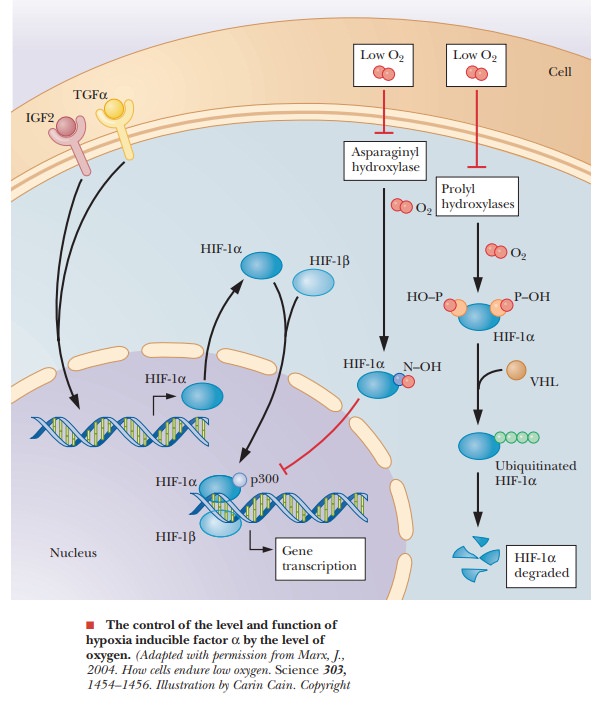Chapter: Biochemistry: Protein Synthesis: Translation of the Genetic Message
How Do We Adapt to High Altitude?
How Do We Adapt to High Altitude?
Those of
us who live at low altitudes are quite aware of the sensations of oxygen
deprivation and the associated physiological changes that occur with prolonged
exposure to high altitudes. Physiologists have studied this phenomenon for many
years, and biochemists have tried to find the mechanism that explains how cells
sense the oxygen partial pressure and make the adaptive changes. Two of the
major changes are the increase in red blood cells, which is stimulated by the
hormone erythropoietin (EPO), and angiogenesis, the stimulation of
formation of new capillaries, which is stimulated by vascular endothelial growth factor(VEGF). Researchers have learned
a great deal about how cellsrespond to low oxygen pressure, or hypoxia, and the results have many
applications, including the production of drugs to treat inflammation, heart
disease, and cancer.
A family
of transcription factors called hypoxia
inducible factors(HIFs) is the key to these processes (see the figure).
Heterodimerscomposed of HIFα and HIFβ subunits bind to DNA and up-regulate a variety
of genes when the partial pressure of oxygen in the blood is low. Oxygen can be
low for many reasons, such as a person being at high altitude or a tissue
having to work unusually hard. During a heart attack or stroke, the oxygen
partial pressure can drop, and these transcription factors can help reduce the
damage.
The genes that are controlled by HIF are responsible for pro-duction of EPO and angiogenesis, as well as production of glyco-lytic enzymes that can provide energy for the cells when aerobic metabolism is compromised. In addition, many types of cancers are found associated with elevated levels of HIF. This may beinvolved in the tumor’s ability to grow, which requires a large oxygen supply. As it turns out, if cell growth is uncon- trolled, the dimerization of the two HIF subunits is unchecked, which would lead to constant expression of the adaptive genes. When this happens, overgrowth of endothelial cells occurs, leading to tumors. Any given cell maintains rela- tively constant levels of the HIFβ subunit, but the level of the HIFα subunit is regu- lated. The system is mainly controlled by the degradation of the HIFα subunit (see the right side of the figure). Proline 564 in the HIFα subunit can be hydroxylated by an enzyme called proline hydroxylase (PH). After it is hydroxylated, it binds to a protein called von Hippel–Lindau pro- tein (pVHL), which was first discovered to be a tumor suppressor. After the pVHL is bound, it stimulates the organization of a complex with ubiq- uitin ligase (UL), which ubiquitinylates the HIFα subunit. Ubiquitin is a 76-residue polypeptide that is very abundant and conserved in eukaryotes. When ubiquitin is put onto a protein, it targets the protein for transport to a proteasome, where the protein is degraded. Searching for how this pathway is related to the body’s abil- ity to sense the oxygen partial pressure is currently an area of active research.
Evidence
exists that the proline hydroxylase has a requirement for iron and oxygen. It
is possible that, in the absence of sufficient oxy-gen, the HIF proline
hydroxylase cannot function. Thus, the HIFα subunit is not targeted for destruction and is
available to bind to the HIFβ subunit, thus forming the active dimer and
stimulating the adaptive effects of reduced oxygen pressure.

A second
control point was recently discovered to be mediated by another hydroxylase.
This time the target is an asparagine resi-due on HIFα. When the HIFα subunit is hydroxylated, it cannot bind to the
transcription mediator, p300, and therefore cannot induce transcription. Thus,
when oxygen is low, two different hydroxylations proceed at reduced levels.
Reduction
of the asparagine’s hydroxylase reaction allows the HIFα to do its job, and reduction of the prolyl
hydroxylase reaction stops degradation of the HIFα by the ubiquitin-linked pathway. Many
researchers believe that these two reactions are the mecha-nism for oxygen
sensing, but others believe they are just incidental to the true mechanism,
which has yet to be discovered.
HIF is
also controlled in a positive way by insulin
growth factor2 (IGF2) and by
transforming growth factor α (TGFα). These arecommon growth factors that are active in several growth
and differ-entiation pathways, and they are not related to oxygen availability.
Researchers
are looking at control of HIF as a potential therapy against cancer because so
many cancers are found to be associated with high HIF levels. Because tumors
need oxygen to grow, stopping the tumor’s activation of HIF-mediated
transcrip-tion could effectively choke out the tumor before it progresses.
Related Topics